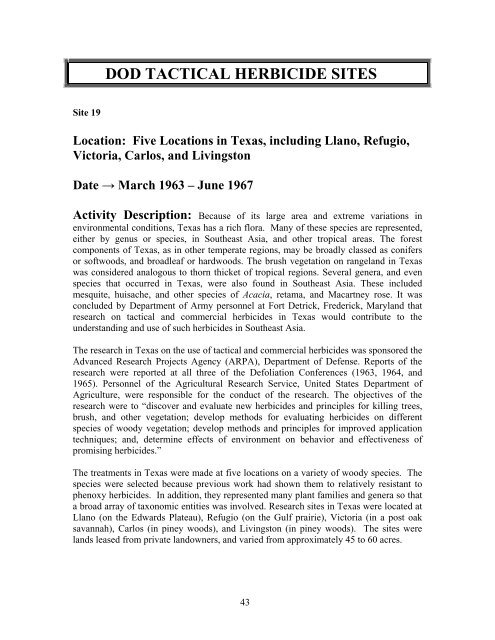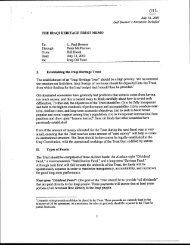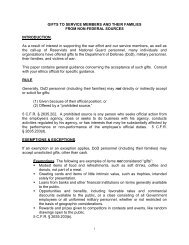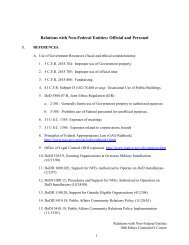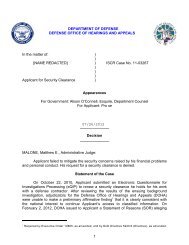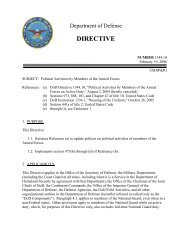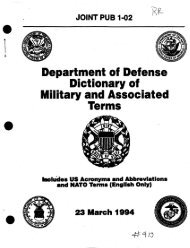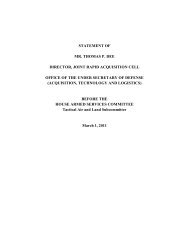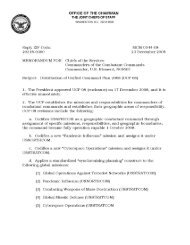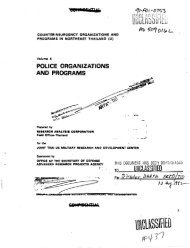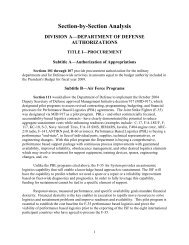dod tactical herbicide sites - United States Department of Defense
dod tactical herbicide sites - United States Department of Defense
dod tactical herbicide sites - United States Department of Defense
You also want an ePaper? Increase the reach of your titles
YUMPU automatically turns print PDFs into web optimized ePapers that Google loves.
DOD TACTICAL HERBICIDE SITESSite 19Location: Five Locations in Texas, including Llano, Refugio,Victoria, Carlos, and LivingstonDate → March 1963 – June 1967Activity Description: Because <strong>of</strong> its large area and extreme variations inenvironmental conditions, Texas has a rich flora. Many <strong>of</strong> these species are represented,either by genus or species, in Southeast Asia, and other tropical areas. The forestcomponents <strong>of</strong> Texas, as in other temperate regions, may be broadly classed as conifersor s<strong>of</strong>twoods, and broadleaf or hardwoods. The brush vegetation on rangeland in Texaswas considered analogous to thorn thicket <strong>of</strong> tropical regions. Several genera, and evenspecies that occurred in Texas, were also found in Southeast Asia. These includedmesquite, huisache, and other species <strong>of</strong> Acacia, retama, and Macartney rose. It wasconcluded by <strong>Department</strong> <strong>of</strong> Army personnel at Fort Detrick, Frederick, Maryland thatresearch on <strong>tactical</strong> and commercial <strong>herbicide</strong>s in Texas would contribute to theunderstanding and use <strong>of</strong> such <strong>herbicide</strong>s in Southeast Asia.The research in Texas on the use <strong>of</strong> <strong>tactical</strong> and commercial <strong>herbicide</strong>s was sponsored theAdvanced Research Projects Agency (ARPA), <strong>Department</strong> <strong>of</strong> <strong>Defense</strong>. Reports <strong>of</strong> theresearch were reported at all three <strong>of</strong> the Defoliation Conferences (1963, 1964, and1965). Personnel <strong>of</strong> the Agricultural Research Service, <strong>United</strong> <strong>States</strong> <strong>Department</strong> <strong>of</strong>Agriculture, were responsible for the conduct <strong>of</strong> the research. The objectives <strong>of</strong> theresearch were to “discover and evaluate new <strong>herbicide</strong>s and principles for killing trees,brush, and other vegetation; develop methods for evaluating <strong>herbicide</strong>s on differentspecies <strong>of</strong> woody vegetation; develop methods and principles for improved applicationtechniques; and, determine effects <strong>of</strong> environment on behavior and effectiveness <strong>of</strong>promising <strong>herbicide</strong>s.”The treatments in Texas were made at five locations on a variety <strong>of</strong> woody species. Thespecies were selected because previous work had shown them to relatively resistant tophenoxy <strong>herbicide</strong>s. In addition, they represented many plant families and genera so thata broad array <strong>of</strong> taxonomic entities was involved. Research <strong>sites</strong> in Texas were located atLlano (on the Edwards Plateau), Refugio (on the Gulf prairie), Victoria (in a post oaksavannah), Carlos (in piney woods), and Livingston (in piney woods). The <strong>sites</strong> werelands leased from private landowners, and varied from approximately 45 to 60 acres.43


